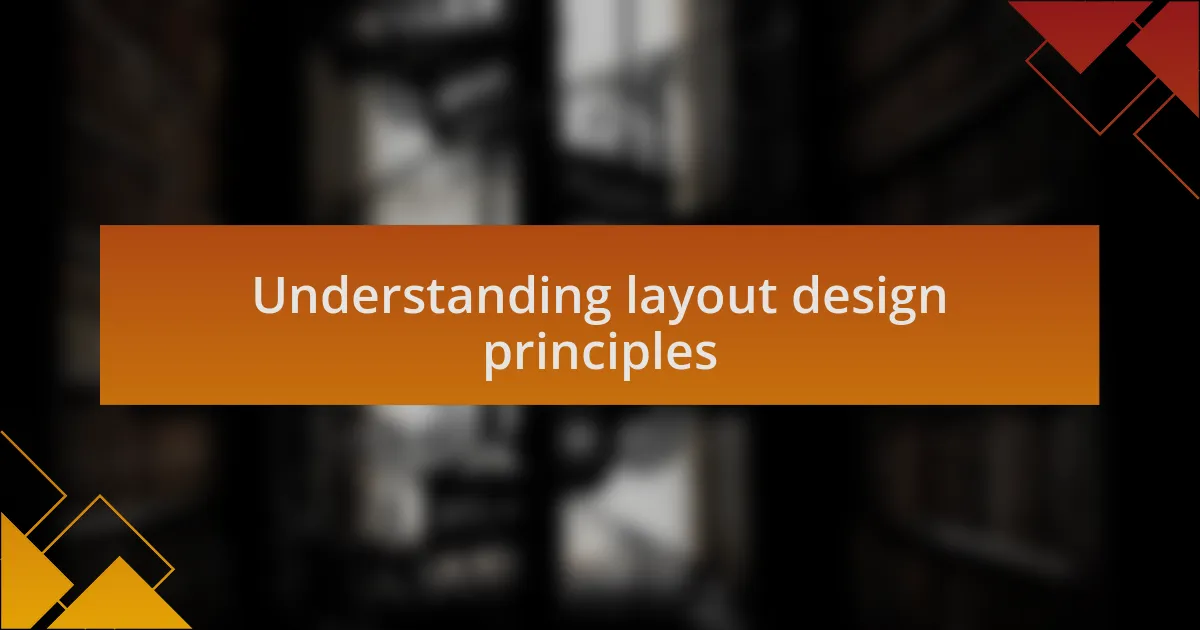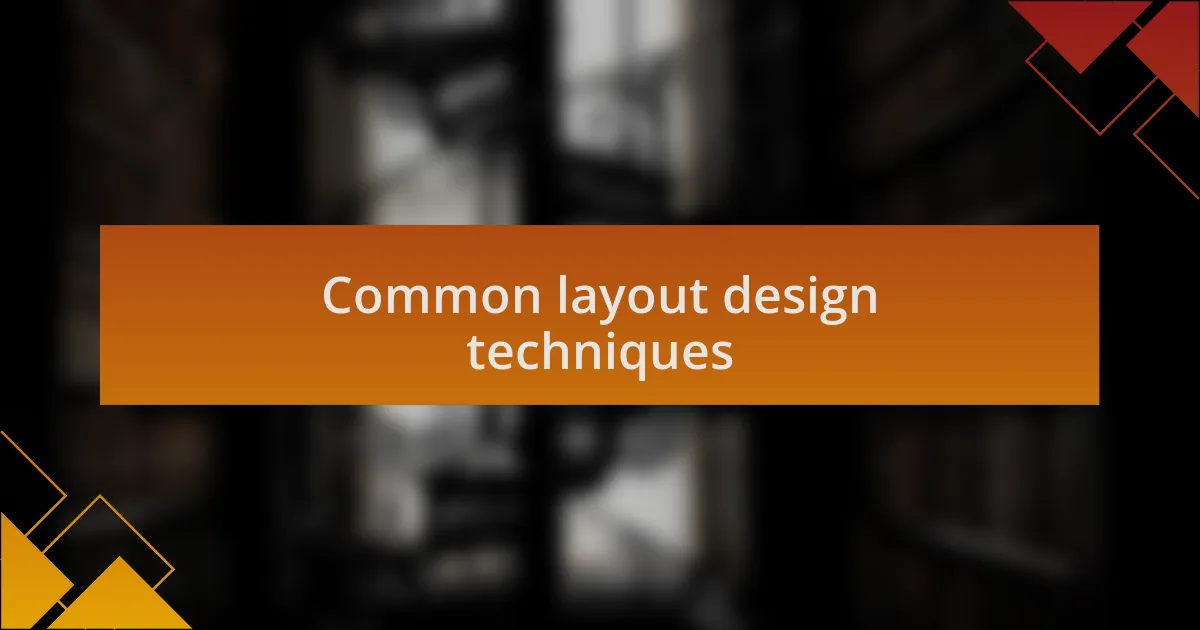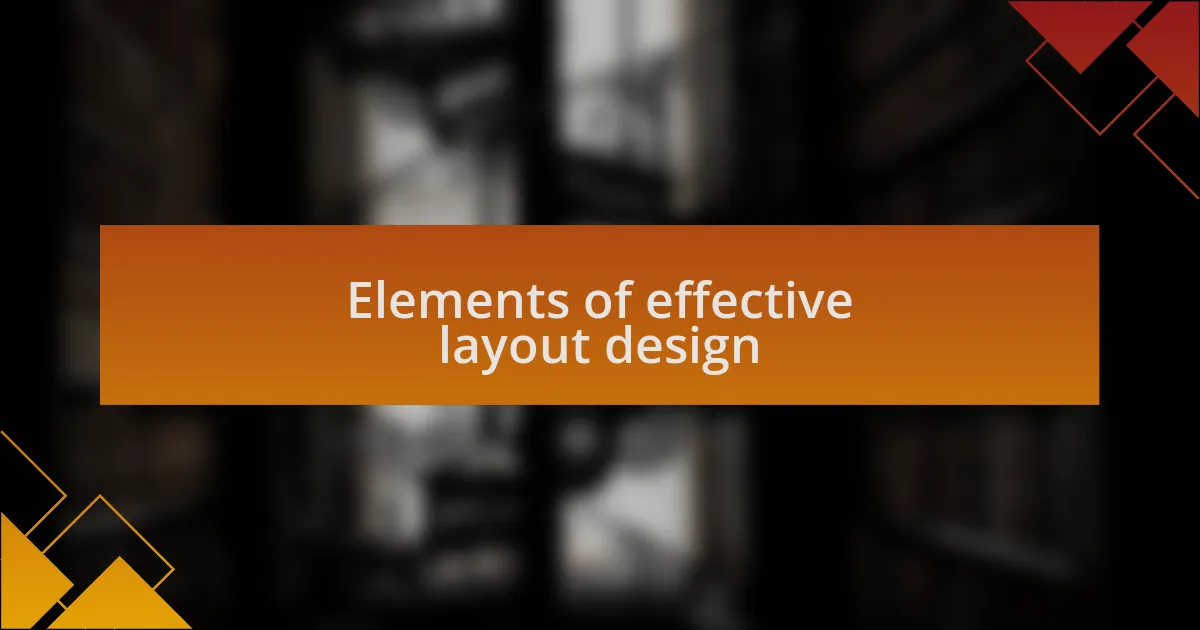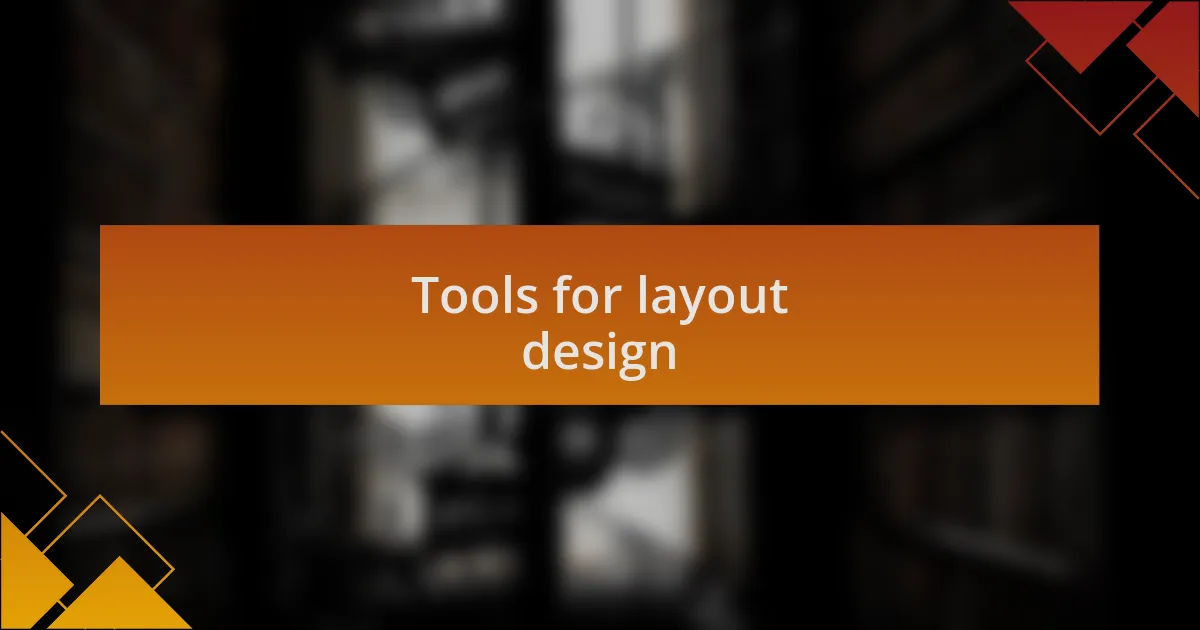Key takeaways:
- Balance and hierarchy are essential in layout design, guiding the viewer’s attention and creating a visually inviting experience.
- Whitespace and strategic use of color enhance clarity and emotional engagement, making content more approachable.
- Consistency and user experience should be prioritized to retain reader interest and ensure seamless navigation.
- Utilizing the right design tools can streamline the layout creation process and improve accessibility for a broader audience.

Understanding layout design principles
When I first delved into layout design principles, I discovered that balance is paramount. It’s fascinating how symmetry can evoke a sense of calm, while asymmetry creates dynamic energy. Have you ever noticed how a perfectly balanced page can make you linger just a bit longer? I certainly have—it’s as if the design invites me in for a closer look.
I also learned that hierarchy is essential in guiding the viewer’s eye. By strategically varying size, color, and placement, I can direct attention to the most important elements. It’s like telling a story visually; the headline catches your eye, and then the body text draws you in deeper. Reflecting on my own experiences, I’ve successfully used hierarchy to enhance content engagement, making it easier for readers to absorb information.
Another key principle I’ve embraced is the importance of whitespace, which often gets overlooked. This breathing room around design elements can transform a cluttered page into an inviting space. I remember a project where reducing noise through whitespace made the content feel less overwhelming; it was a game changer. Isn’t it interesting how the right amount of empty space can focus attention and improve the overall user experience?

Importance of layout in publishing
The layout of a publication serves as the first impression, influencing whether a reader feels compelled to engage with the content. I recall a time when I stumbled upon a self-published book with a chaotic layout—my interest faded instantly. It struck me then just how critical layout is; when everything is thoughtfully arranged, it invites the reader into a world where they feel comfortable exploring.
Visual appeal is one aspect, but functionality plays an equally important role. A well-organized layout can guide readers through the content seamlessly. I once worked on an e-book where I implemented a consistent format for chapters. It was rewarding to see readers comment on its ease of navigation. Have you ever found yourself lost in a disorganized publication? That experience can quickly turn a reader away, proving that effective layout is not just about aesthetics but about retaining interest.
Moreover, a carefully crafted layout can strengthen the message itself. For instance, during my own publishing journey, I chose specific design elements to reflect the tone of the material. I positioned impactful quotes prominently to resonate emotionally, enhancing the narrative. Have you considered how layout can amplify the essence of your message? When design harmonizes with content, it transcends mere decoration; it becomes an essential part of storytelling.

Common layout design techniques
When it comes to layout design techniques, using a grid system has been a game-changer for me. By dividing the page into a grid, elements can be organized in a visually appealing and logical manner. I recall a project where this approach helped me balance text and imagery beautifully, making the overall reading experience feel more intuitive. Have you ever noted how a well-structured layout can enhance clarity?
Another technique I often employ is white space, which allows content to breathe. It’s amazing how a little bit of space around text or images can elevate the overall design. I remember tweaking a layout for a brochure and adding extra white space, which transformed a crowded page into something light and inviting. It made me realize that sometimes, less really is more. How does white space influence your perception of design? In my experience, it can shift a reader’s focus to what truly matters.
Experimenting with hierarchy is another essential practice. This involves adjusting the size, color, or placement of design elements to guide the reader’s attention. I once developed an online article where I bolded key takeaways and placed them at the top of the section. The feedback was phenomenal—readers found it much easier to grasp the main ideas. Can you think of a time when focusing on hierarchy helped you absorb information better? Creating a clear path through the content not only enhances readability but also keeps readers engaged in a meaningful way.

Elements of effective layout design
One crucial element I believe significantly impacts layout design is the strategic use of color. Color can evoke emotions and set the tone for the entire page. For instance, while rebranding my website, I chose a calming palette of blues and greens, which instantly made the space feel more welcoming. Have you ever noticed how a specific color can influence your mood while browsing? Observing this shift in visitor engagement was enlightening.
Typography is another key aspect of layout design that often gets overlooked. The typeface you select not only affects readability but also conveys your brand personality. I vividly recall a project where I switched from a generic font to a more playful one, and it completely transformed the energy of the website. It was gratifying to hear users say they felt the brand’s character come to life through the text. What typefaces resonate with you personally, and how do they complement your content?
Finally, the arrangement of interactive elements plays a vital role in modern web design. Effective layouts guide users seamlessly from one action to the next. When I redesigned a client’s landing page, strategically placing call-to-action buttons in prominent, intuitive locations led to a remarkable spike in conversions. It made me realize how vital it is to anticipate user behavior. Have you experienced the difference a well-placed button can make?

Tools for layout design
When it comes to layout design, selecting the right tools can truly make a difference. I rely heavily on platforms like Adobe XD and Figma for their intuitive interfaces and collaborative features. These tools allow me to create prototype layouts quickly, which, in my experience, has streamlined the feedback process significantly. Have you ever found an easy-to-use tool that changed the way you approached design?
For those working within WordPress, page builders like Elementor or Beaver Builder can be game-changers. I remember using Elementor for a recent project where I needed to build a visually compelling blog layout within a tight deadline. The drag-and-drop functionality made it incredibly simple to experiment with different designs, and I found myself excited to explore endless possibilities. Have you entered a creative flow because of the right tool?
Moreover, accessibility tools like WAVE and Axe have been essential in ensuring my designs reach a broader audience. After integrating these tools into my workflow, I was able to pinpoint issues like insufficient color contrast or missing alt text in images, which made a significant impact on usability. How often do you consider accessibility in your design process? Embracing these tools has not only improved my layouts but also enriched the user experience.

My personal layout design preferences
When it comes to layout design, I have a soft spot for clean, minimalist aesthetics. I find that a simple layout allows content to shine without distractions, which is crucial for independent publishing. There’s something refreshing about a well-organized page that draws the reader in, don’t you think?
I also prefer layouts that incorporate ample white space. This preference stems from my experience of feeling overwhelmed by cluttered designs. I remember visiting a beautifully laid-out site that utilized white space effectively, and it felt like a breath of fresh air. It not only made reading pleasant but also made navigation intuitive. Have you ever experienced that delightful clarity in your browsing?
Engagement is another aspect I prioritize in my layouts. I often incorporate interactive elements, like hover effects or dynamic content sections, which keep the viewer interested. I recall a project where I integrated a scrolling story feature that encouraged readers to dive deeper into the content. It not only captivated my audience but also fostered a sense of connection with the material. What interactive elements have you found effective in your designs?

Tips for successful layout implementation
One effective tip for implementing a successful layout is to prioritize user experience. During one project, I closely analyzed user behavior using heatmaps, and it became evident that certain sections went unnoticed. By adjusting the layout to highlight important content, I saw a significant increase in engagement. Have you ever overlooked something simply because it was poorly placed?
Another key aspect is ensuring consistency throughout the design. I recall a website I relished visiting because its layout was cohesive across pages. This consistency not only fosters brand recognition but also reassures visitors as they navigate through different sections. Think about your favorite sites—what elements make their experience seamless and inviting?
Lastly, testing your layout post-implementation is crucial. I once launched a new design and was surprised by the feedback—it turned out the font size was too small for many readers. Listening to audience input helped me refine the design further. Have you ever made a change based on direct feedback that improved the overall experience?